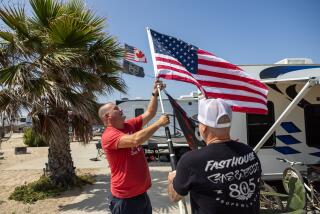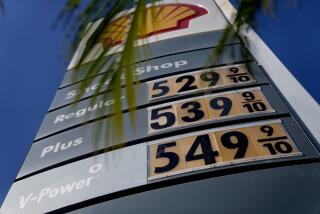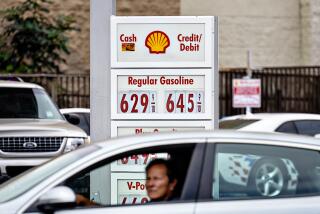Drivers are burning a little less gasoline
Two years of record-high gasoline prices have forced auto-crazed Americans to do something they haven’t done in more than two decades: Drive less.
Auto designer Jack Chen is one of them. Pricey gas made living in Pasadena and working in Ontario a $400-a-month grind.
“I started to reexamine my life overall,” said Chen, 35, who loves muscle cars and drives a Saab 9-2x sports wagon. “I summed up how much I spent on gas and I started having this idea of moving inland.” So last summer, he settled into a Corona apartment and cut his commute to seven miles.
The financial relief was immediate. Before “I had to watch my balance to make sure checks didn’t bounce,” Chen said. “I don’t have to worry about that these days.”
Few have made such drastic lifestyle changes. But to the surprise of many economists, U.S. motorists changed their ways enough to cut the nation’s per-driver mileage by 0.4% in 2005, ending a string of increases dating back to 1980, government data show.
Other reports over the last year on mass transit ridership, total miles driven nationwide, gasoline demand, vehicle sales and retail and restaurant spending reinforce the notion that U.S. drivers made significant -- and in some cases, lasting -- adjustments to offset steadily rising gasoline prices.
“In 2005 and into 2006, we did see consumers start to change their driving behavior,” said David Portalatin, director of industry analysis at NPD Group Inc., which tracks consumer spending. “That’s a very hard thing to change, because I’ve either got to change where I work, where I live, or what kind of car I drive in order to actually consume less gasoline.”
It’s a small but important shift for a nation that many believed was impervious to rising gas prices because drivers were unable or unwilling to rein in their gas-guzzling ways. Lofty energy costs have generated such concern that President Bush devoted a significant chunk of his last two State of the Union speeches to addressing the nation’s oil addiction.
“The message is that price matters,” said Daniel Yergin, chairman of Cambridge Energy Research Associates, a Boston-area consulting company that recently published an analysis called “Gasoline and the American People.” The study highlighted the decline in per-driver mileage and a cooling appetite for the largest sport utility vehicles, among other things, and concluded that expensive gasoline was transforming “America’s love affair with the automobile.”
Even though pump prices have dropped substantially from their highs in 2006, “there’s a greater sense of insecurity, and people don’t want to be caught emptying their wallet at the gasoline pump,” said Yergin, author of “The Prize,” a Pulitzer-winning history of the oil industry.
That anxiety has shown up in California, where average gas prices stayed above the $3 mark for more than four months last year and triggered an unexpected dip in gasoline usage.
Through the first nine months of 2006, gasoline sales fell 0.6% compared with the same period a year earlier, according to the state Board of Equalization.
In car-centric Los Angeles, ridership rose more than 6% on Metrolink trains and 5.7% on the buses and trains run by the Los Angeles Metropolitan Transportation Authority through the first nine months of the year.
“Usually, when gas prices go up, and then come down, ridership would go up, then we would see it go back down, but this time we are keeping it,” MTA spokesman Jose Ubaldo said. “It’s amazing.”
Oil companies, however, need not fret. A steady economy, growing population and longer commutes will keep U.S. gasoline consumption chugging along for years, despite the uptick in sales of fuel-saving hybrid cars and the growing use of biofuels such as ethanol.
While high prices cut into the expected growth rate, U.S. gasoline consumption nonetheless increased by about 1% in 2006 after staying flat the previous year. “The gasoline consumed since that August peak in gasoline prices is up nearly 2.5% versus the comparable time period a year ago,” said Portalatin, the NPD researcher. “What it means is that consumers have a short memory.”
Retiree Joe McElroy of Fountain Valley admits to being a backslider. When local gas costs jumped last summer, McElroy consolidated errands and trimmed trips to visit Riverside relatives. But, he acknowledged, “when prices eased up, I kind of relaxed on that cutback and went ahead and did a little more driving.”
That response is what economists have come to expect. Decades of studies invariably conclude that big spikes in prices at the pumps produce only tiny short-term cutbacks in demand. If that research is any guide, whatever changes motorists made during the recent gas-price spikes would be wiped out by recently plunging prices outside of California.
But some transportation experts say that a handful of new factors are starting to turn the tide, causing some consumption changes to stick despite lower prices.
Some believe drivers are reacting to the increasing volatility and the steady upward march of gasoline prices over the last few years.
After enjoying lower pump prices in 2001 and 2002, consumers saw the yearly average cost of gas jump by double digits in each of the next four years.
Another reason is that the nation’s baby boomers are getting older, and many are approaching retirement age. Older drivers tend to drive less, especially if they are freed from a daily commute. Today, more than 14% of U.S. drivers are over 65 -- nearly double the level in 1980, according to the study by the Cambridge energy research group.
And some consumers are increasingly driven to conserve fuel because of a growing uneasiness about the nation’s addiction to oil, the instability of oil-rich countries and the harmful climate effects that stem from petroleum use.
All this has car companies rolling out new gas-electric hybrid vehicles and touting fuel efficiency at every opportunity, a sign that those companies believe the public’s yen for saving gas is not a fleeting fancy.
Automakers “are keeping in mind that this is a real issue, and it’s a real problem for the American driver that they have to deal with,” said Lonnie Miller, director of industry analysis at R.L. Polk & Co., a Southfield, Mich., company that tracks vehicle sales.
William Millar, president of the American Public Transportation Assn., has seen many cycles where mass transit ridership grew as gas prices rose only to crater afterward when fuel costs returned to more normal levels. But things are different now, he said.
“After Katrina, when many parts of the country saw prices above $3 a gallon, we saw an immediate increase in ridership,” he said. Tulsa, Okla., which has a small bus system, saw ridership jump 28% for the nine months after Hurricane Katrina. “When you see it in places like that, it says to me that there’s a fundamental shift going on.”
As prices dropped, “some people went back to their cars,” Millar said. “But I was pleasantly surprised by the breadth of the growth, and with the relatively small decline when prices went down.”
Nationwide, trips on buses, rail and other public transit jumped the most when the average cost of gas topped $3 a gallon, according to figures from the trade group. But even with some subsequent drop-off, overall ridership was up nearly 3% through the first nine months of 2006, roughly double the typical annual increase, Millar said.
But Americans clearly have their limits when it comes to conserving fuel. One item that’s definitely not on the to-do list: Driving slower. Several states have boosted highway speed limits over the last two years.
“I’m surprised that I see people driving at 75 or 80 miles an hour on [interstate] 680 out here,” Chevron Corp. Chief Executive David O’Reilly said during an August interview at the oil company’s headquarters in San Ramon, Calif. “If they drove at 60 miles an hour, they’d save 5% or 10% of their gasoline consumption.”
Fountain Valley retiree McElroy is one of the few who has tried that tactic.
“I try to ease up on the accelerator ... keep it to 70 or below, when everybody else is doing 80,” he said. “It probably does irritate other drivers a little bit. I just have to stay pretty far to the right and stay out of the carpool lane.”
*
elizabeth.douglass@latimes.com






